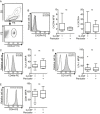The CXCR4 and adhesion molecule expression of CD34+ hematopoietic cells mobilized by "on-demand" addition of plerixafor to granulocyte-colony-stimulating factor
- PMID: 24673458
- PMCID: PMC4215600
- DOI: 10.1111/trf.12632
The CXCR4 and adhesion molecule expression of CD34+ hematopoietic cells mobilized by "on-demand" addition of plerixafor to granulocyte-colony-stimulating factor
Abstract
Background: Granulocyte-colony-stimulating factor (G-CSF) is routinely used for mobilization of hematopoietic stem and progenitor cells preceding autologous transplantation after high-dose chemotherapy in hematologic malignancies. However, due to high mobilization failure rates, alternative mobilization strategies are required.
Study design and methods: Patients who poorly mobilized CD34+ hematopoietic cells (HCs) with G-CSF additionally received the CXCR4 antagonist plerixafor. The phenotype of CD34+ HCs collected after this plerixafor-induced "rescue" mobilization, in regard to adhesion molecule and CD133, CD34, and CD38 expression in comparison to CD34+ HCs collected after traditional G-CSF administration in good mobilizers, was analyzed flow cytometrically. To confirm previous studies in our patient cohort, the efficiency of mobilization and subsequent engraftment after this "on-demand" plerixafor mobilization were analyzed.
Results: Pronounced mobilization occurred after plerixafor administration in poor mobilizers, resulting in similar CD34+ cell yields as obtained by G-CSF in good mobilizers, whereby plerixafor increased the content of primitive CD133+/CD34+/CD38- cells. The surface expression profiles of the marrow homing and retention receptors CXCR4, VLA-4, LFA-1, and CD44 on mobilized CD34+ cells and hematopoietic recovery after transplantation were similar in patients receiving G-CSF plus plerixafor or G-CSF. Unexpectedly, the expression levels of respective adhesion receptors were not related to mobilization efficiency or engraftment.
Conclusion: The results show that CD34+ HCs collected by plerixafor-induced rescue mobilization are qualitatively equivalent to CD34+ HCs collected after traditional G-CSF mobilization in good mobilizers, in regard to their adhesive phenotype and engraftment potential. Thereby, plerixafor facilitates the treatment of poor mobilizers with autologous HC transplantation after high-dose chemotherapy.
© 2014 The Authors. Transfusion published by Wiley Periodicals, Inc. on behalf of AABB.
Figures



 ) patients treated with G-CSF plus plerixafor (n = 8). *p < 0.05; **p < 0.01; ***p < 0.001; ns = not significant.
) patients treated with G-CSF plus plerixafor (n = 8). *p < 0.05; **p < 0.01; ***p < 0.001; ns = not significant.
 ) patients receiving G-CSF plus plerixafor.
) patients receiving G-CSF plus plerixafor.
Similar articles
-
PEGylated Granulocyte Colony-Stimulating Factor and Plerixafor Enhance Autologous Stem and Progenitor Cell Mobilization and Transplantation in Pediatric Patients.Stem Cells Dev. 2025 Feb;34(3-4):61-72. doi: 10.1089/scd.2024.0178. Epub 2025 Jan 16. Stem Cells Dev. 2025. PMID: 39817857
-
Plerixafor plus granulocyte colony-stimulating factor versus placebo plus granulocyte colony-stimulating factor for mobilization of CD34(+) hematopoietic stem cells in patients with multiple myeloma and low peripheral blood CD34(+) cell count: results of a subset analysis of a randomized trial.Biol Blood Marrow Transplant. 2012 Oct;18(10):1564-72. doi: 10.1016/j.bbmt.2012.05.017. Epub 2012 Jun 6. Biol Blood Marrow Transplant. 2012. PMID: 22683613 Clinical Trial.
-
Accelerated lymphocyte reconstitution and long-term recovery after transplantation of lentiviral-transduced rhesus CD34+ cells mobilized by G-CSF and plerixafor.Exp Hematol. 2011 Jul;39(7):795-805. doi: 10.1016/j.exphem.2011.04.002. Epub 2011 Apr 15. Exp Hematol. 2011. PMID: 21549175 Free PMC article.
-
Plerixafor: A chemokine receptor-4 antagonist for mobilization of hematopoietic stem cells for transplantation after high-dose chemotherapy for non-Hodgkin's lymphoma or multiple myeloma.Clin Ther. 2010 May;32(5):821-43. doi: 10.1016/j.clinthera.2010.05.007. Clin Ther. 2010. PMID: 20685493 Review.
-
Plerixafor: a review of its use in stem-cell mobilization in patients with lymphoma or multiple myeloma.Drugs. 2011 Aug 20;71(12):1623-47. doi: 10.2165/11206040-000000000-00000. Drugs. 2011. PMID: 21861545 Review.
Cited by
-
Mobilization of human immature hematopoietic progenitors through combinatory use of bortezomib and immunomodulatory drugs.Int J Hematol. 2017 Apr;105(4):423-432. doi: 10.1007/s12185-016-2148-2. Epub 2016 Nov 21. Int J Hematol. 2017. PMID: 27873175
-
Homing Genes Expression in Fucosyltransferase VI-Treated Umbilical Cord Blood CD133+ Cells which Expanded on Protein-Coated Nanoscaffolds.Mol Biotechnol. 2018 Jul;60(7):455-467. doi: 10.1007/s12033-018-0086-3. Mol Biotechnol. 2018. PMID: 29730712
-
Innate Immunity and Mobilization of Hematopoietic Stem Cells.Curr Stem Cell Rep. 2017;3(3):172-180. doi: 10.1007/s40778-017-0087-3. Epub 2017 Jul 10. Curr Stem Cell Rep. 2017. PMID: 28845386 Free PMC article. Review.
-
Expression of adhesion molecules on CD34+ cells from steady-state bone marrow before and after mobilization and their association with the yield of CD34+ cells.Blood Res. 2018 Mar;53(1):61-70. doi: 10.5045/br.2018.53.1.61. Epub 2018 Mar 27. Blood Res. 2018. PMID: 29662864 Free PMC article.
-
The Biological and Clinical Relevance of G Protein-Coupled Receptors to the Outcomes of Hematopoietic Stem Cell Transplantation: A Systematized Review.Int J Mol Sci. 2019 Aug 9;20(16):3889. doi: 10.3390/ijms20163889. Int J Mol Sci. 2019. PMID: 31404983 Free PMC article.
References
-
- Bensinger W, DiPersio JF, McCarty JM. Improving stem cell mobilization strategies: future directions. Bone Marrow Transplant. 2009;43:181–195. - PubMed
-
- Gratwohl A, Baldomero H, Schwendener A, et al. The EBMT activity survey 2008: impact of team size, team density and new trends. Bone Marrow Transplant. 2011;46:174–191. - PubMed
-
- Kollet O, Dar A, Shivtiel S, et al. Osteoclasts degrade endosteal components and promote mobilization of hematopoietic progenitor cells. Nat Med. 2006;12:657–664. - PubMed
-
- Motabi IH, DiPersio JF. Advances in stem cell mobilization. Blood Rev. 2012;26:267–278. - PubMed
Publication types
MeSH terms
Substances
Grants and funding
LinkOut - more resources
Full Text Sources
Other Literature Sources
Research Materials
Miscellaneous

